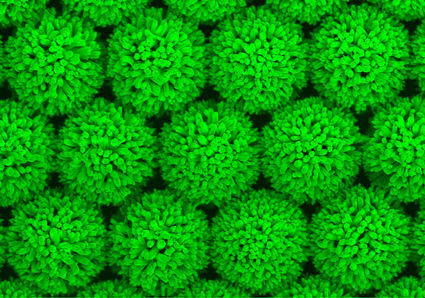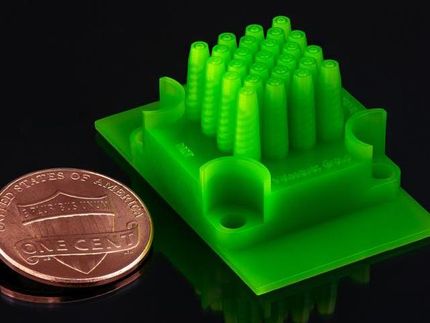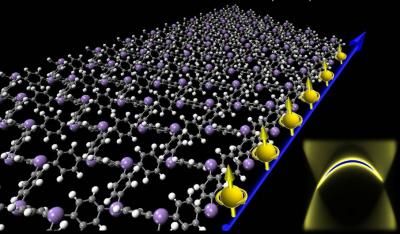Empa grows 'sea urchin'-shaped structures: More efficient photocells thanks to nanostructured surfaces
Processes which lend materials new characteristics are generally complicated and therefore often rather difficult to reproduce. So surprise turns to astonishment when scientists report on new methods which not only produce outstanding results despite the fact that they use economically priced starting materials but also do not need expensive instrumentation.

These are "sea urchins" made of tiny polystyrene balls, with zinc oxide nanowire "spines" are created using a simple electrochemical process.
Empa
Just a simple framework made of polystyrene
This is exactly what Jamil Elias and Laetitia Philippe of Empa's Mechanics of Materials and Nanostructures Laboratory in Thun have succeeded in doing. They used polystyrene spheres as a sort of scaffolding to create three-dimensional nanostructures of semiconducting zinc oxide on various substrates. The two scientists are convinced that the (nanostructured) «rough» but regularly-structured surfaces they have produced this way can be exploited in a range of electronic and optoelectronic devices such as solar cells and also short wave lasers, light emitting diodes and field emission displays.
The principle behind the process is quite simple. Little spheres of polystyrene a few micrometers in diameter are placed on an electrically conducting surface where they orient themselves in regular patterns. Polystyrene is cheap and ubiquitous – it is widely used as a packaging material (for example for plastic yoghurt pots) or as insulating material in expanded form as a solidified foam.
Hollow bodies with prickles for photovoltaic applications
The tiny balls of polystyrene anchored in this way form the template on which the nanowires are desposited. Jamil Elias has succeeded in using an electrochemical method which himself has developed to vary the conductivity and electrolytic properties of the polystyrene balls in such way that the zinc oxide is deposited on the surface of the microspheres. Over time regular nanowires grow from this surface, and when this process is complete the polystyrene is removed, leaving behind hollow spherical structures with spines – little sea-urchins, as it were! Tightly packed on the underlying substrate, the sea-urchins lend it a three-dimensional structure, thereby increasing considerably its surface area.
This nanostructured surface is predestined for use in photovoltaic applications. The researchers expect that it will have excellent light scattering properties. This means the surface will be able to absorb significantly more sunlight and therefore be able to convert radiated energy into electricity more efficiently. In a project supported by the Swiss Federal Office of Energy (SFOE), Laetitia Philippe and her research team are developing extremely thin absorbers (ETAs) for solar cells, based these zinc oxide nanostructures.
Original publication: Elias, C. Lévy-Clément, M. Bechelany, J. Michler, G.-Y. Wang, Z. Wang, L. Philippe; "Hollow Urchin - like ZnO thin Films by Electrochemical Deposition, Advanced Materials, Volume 22, Issue 14, Pages 1607-1612 (April 12, 2010)
Topics
Organizations
Other news from the department science

Get the chemical industry in your inbox
By submitting this form you agree that LUMITOS AG will send you the newsletter(s) selected above by email. Your data will not be passed on to third parties. Your data will be stored and processed in accordance with our data protection regulations. LUMITOS may contact you by email for the purpose of advertising or market and opinion surveys. You can revoke your consent at any time without giving reasons to LUMITOS AG, Ernst-Augustin-Str. 2, 12489 Berlin, Germany or by e-mail at revoke@lumitos.com with effect for the future. In addition, each email contains a link to unsubscribe from the corresponding newsletter.


























































